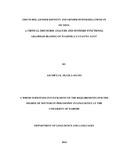| dc.description.abstract | The study sought to investigate how the language used by both male and female
interlocutors, as well as the language used to talk about male and female characters in a
literary text serves to position men and women as specific types of social actors. Specific
focus was on how language is called upon to signify, produce, reproduce and contest
asymmetrical gender power relations.The study also sought to unpack the gender ideologies
that help sustain unequal gender power relations. Data for the study was obtained from
selected representative excerpts from Wamitila’s Unaitwa Nani?. Reference was also made
to other literary works by Wamitila, as well as literary works by other Kenyan and non-
Kenya literary scholars. The study was hinged on the theoretical underpinnings of Critical
Discourse Analysis. Systemic Functional Linguistics was used as an adjunct theory that
provided the linguistic tools for analysis. Qualitative research design was employed in this
study. A qualitative approach to the analysis of data, using Fairclough’s (1989, 2010) three
tier procedure of description, interpretation and explanation was adopted. This means that
the study was descriptive in nature, focusing on both micro and macro discourse analysis. At
the micro or text level, analysis focused on describing the transitivity patterns, lexical
choices, mood and modality structures, and other discourse strategies, interpreting the
linguistic features and discourse strategies drawn upon in specific interactions, and at the
macro level, explaining as well as assessing the extent to which the choice of transitivity
patterns, lexical items, and mood and modality structures position male and female
interlocutors in the gender power relations matrix, as well as how it confirms or challenges
the dominant gender ideology and social relations of power
Ideational, interpersonal, as well as the textual patterning of the selected excerpts revealed
that power is discursively negotiated by both men and women in specific communicative
events. Participants who occupied positions of power, either in the organizational hierarchy
or interactionally, made linguistic choices to signify and reaffirm their status. Discursively,
the more powerful participants seemed to claim longer turns in which they managed to
constrain their interlocutors’ contribution, hence extensively develop their topics in favour
of the kind of gender identity and gender power relations they wanted to communicate to the
reader. The study also demonstrated that context invariably affected how power is conceived
as well as how it is exercised, by constraining the subject positions a participant can occupy
in a certain discursive event. Further, the study suggested that in Unaitwa Nani?, power is
more effectively exercised through hegemony where the more powerful and indeed the
author uses discursive strategies which position the less powerful and by extension the
reader to interpret the world from the world view of the more powerful.
The significance of this study lies in the possibilities for future research.The study is
pioneering in providing a comprehensive analysis of the transitivity patterns as well as the
mood and modality structures that code Wamitila’s world view about gender power relations
in Kenya. | en_US |

